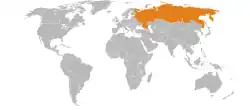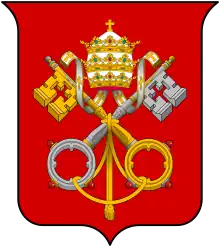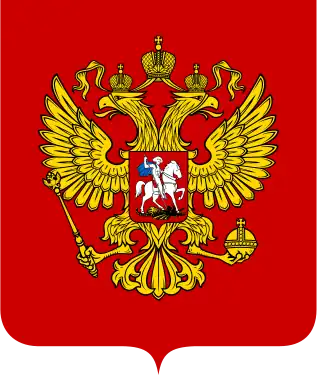Holy See–Russia relations
Holy See–Russia relations (Russian: Российско-Ватиканские отношения) are the bilateral relations between the Holy See and Russia. The Holy See has an Apostolic Nunciature in Moscow. Russia has a permanent representative to the Holy See based in Rome.
 | |
Holy See |
Russia |
|---|---|
As the Russian Orthodox Church is the largest organization of Eastern Orthodoxy, Holy See–Russia relations partly reflect Catholic Church and Eastern Orthodox Church relations.
Ecumenical relations
Holy See–Russia relations are largely linked to ecumenical relations with the Russian Orthodox Church.
Relationship before the 1917 revolution
Pope Pius IX, who faced his own problems with revolutionary movements in his Church State, first tried to position himself in the middle, strongly opposing revolutionary and violent opposition against the Russian authorities and appealing to them for more Church freedom.
Era of the Soviet Union
John Paul II
There were mixed reactions in Russia on the papacy of Pope John Paul II. Many Russians were happy that John Paul had reduced the influence of atheistic Communism in Eastern Europe and contributed to a rebirth of Christianity in the country. However, many others did not like the fact that the fall of the Soviet Union had also provoked a loss of Russian influence in Eastern Europe. The fact that John Paul was Polish also caused tensions, since there is a historic ethno-religious rivalry between Poland and Russia.
After 1991

After 1991, the Russian government started a dialogue with the Vatican.
The Holy See and the Russian Federation established full diplomatic relations in December 2009 following the meeting between Pope Benedict XVI and Russian President Dimitry Medvedev.[2] President Vladimir Putin helped to arrange a meeting between the Pope and Patriarch Kirill at Havana, Cuba in 2016.[3] The meeting also resulted in the two promulgating a joint declaration.[4]
On 4 July 2019, however, it was revealed that tensions still remained between the Vatican and Russia, with the Russian Orthodox Church and Ukrainian conflict serving as the major causes of these tensions.[5] Despite holding a "cordial" meeting with Russian President Vladimir Putin in the Vatican, Pope Francis stated it is unlikely that he will visit Russia unless Putin agrees to not include the Russian Orthodox Church in the invitation, which Putin stated would be unlikely as well.[5] Pope Francis has also declared support for the Ukrainian Greek Catholic Church, which has expressed opposition to Putin and the Russian Orthodox Church and also the 2016 joint declaration.[6][5]
See also
References
- Archived at Ghostarchive and the Wayback Machine: "Dmitry Medvedev on Music, Religion and His Rise to Power". YouTube.
- "Russia and the Vatican establish full diplomatic ties". London: BBC News. 3 December 2009. Archived from the original on 21 August 2013. Retrieved 3 December 2009.
- Povoledo, Elisabetta; Yardley, Jim (February 5, 2016). "In Historic Move, Pope to Meet With Leader of Russian Orthodox Church". The New York Times. New York City. Archived from the original on August 9, 2017.
The Russian church is closely aligned with the Russian government...and the meeting with the pope would have required permission from Mr. Putin. Signing off on the meeting allows the Russian president to show the different avenues he can use to avoid isolation.
- "Full text of joint declaration signed by Pope Francis and Patriarch Kirill".
- "Pope meets Putin; two leaders talk about Ukraine, Syria, Venezuela". Crux. Retrieved 2022-11-13.
- "What Putin wants from the Pope". 4 July 2019.
External links
- (in Russian) Documents on the Holy See – Russia relationship from the Russian Ministry of Foreign Affairs
- Benedict XVI receives President of the Russian Federation Video of meeting between Pope Benedict XVI and President Dmitry Medvedev from Official YouTube channel of the Vatican. 3 December 2009, Retrieved 20 November 2010

